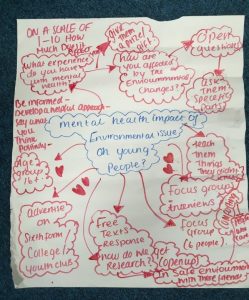- My Imperial Global Development Fellows Fund Placement at Imperial
- Researchers and community members working together to shape research on respiratory infections in young children
- HOPE for Hand Osteoarthritis
- Having an Impact with Public Involvement in Paediatric Intensive Care Research
- Public engagement and involvement at the Cardiomyopathy UK conference: When researchers and the public meet
In conversation with: Rhiannon Thompson, PhD student working within the Imperial College Department of Epidemiology and Biostatistics and the SCAMP study
 What did you do?
What did you do?
As part of my PhD project, I wanted to find out more about how adolescents are affected by their physical environments (their thoughts and feelings about urban and rural places, buildings and traffic, greenspace, nature, noise, etc). To begin with, I recruited 12 teenagers for a project design workshop where we brainstormed ideas for how this question could be answered. Then, two of the attendees reviewed some draft documents: recruitment advert, participant information sheet and consent form. Finally, through three more workshops and independent working, two more of the teenagers worked with me to design interviews and to qualitatively analyse the data for themes.
What were you trying to achieve?
Firstly, I wanted the research to be effective for collecting valuable information from this age group; therefore I asked for feedback from young people on my methods and choice of questions. Secondly, I wanted the research to be acceptable and accessible for participants, so sought a teenage perspective on the participant information sheet, advertising, and interview protocol. Thirdly, I wanted our interpretations of the interviews to reflect what was expressed about the young peoples’ experience, so chose to work with young people to analyse the data. Finally, I wanted results to be relevant, interesting, and available to young people, so sought teenage insights on what questions we should ask and when drafting a manuscript, and I will be seeking further guidance on sharing findings when they’re published.
Who did you involve and how did you find the appropriate people?
In total I involved 13 teenagers age 14-19 from a range of backgrounds at different stages of the project. They were recruited from social and professional networks (e.g. via Imperial’s Young People’s Advisory Network, school contacts, social media).

Were the people you involved given any training?
All sessions started with a brief introduction and background to the question or methods being discussed. In addition, the two co-researchers (young people) who conducted analyses with me were given a half day training session on qualitative thematic analysis including examples and time for practice.
Did you achieve what you set out to do?
Thanks to the group’s support in the design of the project and materials, I managed to recruit and gather lots of data from a range of young people through many interesting interviews. In qualitative analysis, the codes and interpretations offered by the co-researchers were different to mine and really added to the richness, and no doubt accuracy, of how we summarised the responses into themes and the conclusions we drew. For example, the adolescents were interested in the sources of information used by teenagers and added codes to do with this, and often picked up on emotions (e.g. anger) coming through the language which I hadn’t noticed. Trying to find the overlap and a coherent structure collectively was complex but really worth it! By adding questions that they were interested in to the interview plan, particularly about social context and influences, it is hoped that the results should be more interesting to young people. The answers to these questions also had interesting policy implications regarding how best to work with teenagers (e.g. the importance of peers and social media) which I wouldn’t have been able to discuss without the teenagers suggesting we ask those questions.
What impact did the Public Involvement and/or Engagement have on the people?
For me, it was really enjoyable and inspiring to see the impact the young people had on the project- they were a joy to work with and made it better in so many ways, from creating appealing recruitment content to accurately interpreting the data. I think I learnt a lot about how teenagers think and I feel more confident doing public involvement going forward. The young people gained skills and experience for their CVs (many were interested in studying related subjects at university).
Feedback/Quotes from participants (“the best bit of the workshop was…”)
“Meeting the other people and hearing their views and actually talking about this.”
“engaging with researchers, broadening my horizons, hearing about everyone else’s opinion”
Other quotes from participants:
“The workshop was great, and we had interesting discussions which took place and I hoped what we said will help you with your project in the future.”
“I hope that further discussions will have a bigger and wider impact on us and our society!”
What was the most challenging part of doing Public Involvement and/or Engagement and how did you overcome it?
There is quite a lot of administrative work involved in recruiting members of the public, organising events, liaising as to people’s availability, and generating materials for presentations, workshops, training etc. And, for the under 16s, it was necessary to get parental informed consent as well as participant assent. You also have to be adaptable when trying to gauge the level of understanding and pace you should go at with a given group of people. This includes responding to their questions and needs in order to make the project accessible for them and to work together as well as possible. You also have to be willing to learn from them and change your mind about things; you might think you have a clear idea of how you want to do things but they bring expertise and a perspective which might be different.
What advice would you give other researchers interested in doing something like this?
Don’t be intimidated by working with the public or young people, and be open minded as to the direction in which involving the public might take the research.
So, what’s next?
We have submitted the manuscript of the findings to a journal with the two young people who supported the analysis as co-authors. When it is being published, I want to ask some of the young people’s group to help me share the findings with other young people e.g. create a summary or infographic that’s suitable and share it in places that young people will find it and be able to access it.
Since involving the teenagers in my project, I have been involved in more public involvement within my larger team project, e.g. setting up a Young People’s Advisory Group, and I want to keep making it a part of my work going forward.
